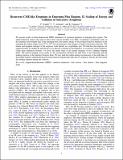Files in this item
Recurrent CME-like eruptions in emerging flux regions. II. Scaling of energy and collision of successive eruptions
Item metadata
| dc.contributor.author | Syntelis, P. | |
| dc.contributor.author | Archontis, V. | |
| dc.contributor.author | Tsinganos, K. | |
| dc.date.accessioned | 2019-05-24T15:35:15Z | |
| dc.date.available | 2019-05-24T15:35:15Z | |
| dc.date.issued | 2019-05-03 | |
| dc.identifier | 259078780 | |
| dc.identifier | 40beea0d-b50d-45f3-be00-ca9b881df2a6 | |
| dc.identifier | 85067303134 | |
| dc.identifier | 000466892200008 | |
| dc.identifier.citation | Syntelis , P , Archontis , V & Tsinganos , K 2019 , ' Recurrent CME-like eruptions in emerging flux regions. II. Scaling of energy and collision of successive eruptions ' , Astrophysical Journal , vol. 876 , no. 1 , 61 . https://doi.org/10.3847/1538-4357/ab16d2 | en |
| dc.identifier.issn | 1538-4357 | |
| dc.identifier.other | RIS: urn:10DE9EB3D5ABD38A56C728FB538741A9 | |
| dc.identifier.other | ORCID: /0000-0002-6926-8676/work/73700876 | |
| dc.identifier.other | ORCID: /0000-0002-6377-0243/work/77131788 | |
| dc.identifier.uri | https://hdl.handle.net/10023/17758 | |
| dc.description | This project has received funding from the Science and Technology Facilities Council (UK) through the consolidated grant ST/N000609/1. The authors acknowledge support by the Royal Society. This work was supported by computational time granted from the Greek Research & Technology Network (GRNET) in the National HPC facility—ARIS. | en |
| dc.description.abstract | We present results of three-dimensional MHD simulations of recurrent eruptions in emerging flux regions. The initial numerical setup is the same as that in the work by Syntelis et al. Here, we perform a parametric study on the magnetic field strength (B 0) of the emerging field. The kinetic energy of the produced ejective eruptions in the emerging flux region ranges from 1026 to 1028 erg, reaching up to the energies of small coronal mass ejections. The kinetic and magnetic energies of the eruptions scale linearly in a logarithmic plot. We find that the eruptions are triggered earlier for higher B 0 and that B 0 is not directly correlated to the frequency of occurrence of the eruptions. Using large numerical domains, we show the initial stage of the partial merging of two colliding erupting fields. The partial merging occurs partly by the reconnection between the field lines of the following and the leading eruption at the interface between them. We also find that tether-cutting reconnection of the field lines of the leading eruption underneath the following eruption magnetically links the two eruptions. Shocks develop inside the leading eruption during the collision. | |
| dc.format.extent | 8 | |
| dc.format.extent | 2733666 | |
| dc.language.iso | eng | |
| dc.relation.ispartof | Astrophysical Journal | en |
| dc.subject | Magnetohydrodynamics (MHD) | en |
| dc.subject | Methods: numerical | en |
| dc.subject | Sun: activity | en |
| dc.subject | Sun: interior | en |
| dc.subject | Sun: magnetic fields | en |
| dc.subject | QB Astronomy | en |
| dc.subject | NDAS | en |
| dc.subject.lcc | QB | en |
| dc.title | Recurrent CME-like eruptions in emerging flux regions. II. Scaling of energy and collision of successive eruptions | en |
| dc.type | Journal article | en |
| dc.contributor.sponsor | Science & Technology Facilities Council | en |
| dc.contributor.institution | University of St Andrews. Applied Mathematics | en |
| dc.identifier.doi | 10.3847/1538-4357/ab16d2 | |
| dc.description.status | Peer reviewed | en |
| dc.identifier.grantnumber | ST/N000609/1 | en |
This item appears in the following Collection(s)
Items in the St Andrews Research Repository are protected by copyright, with all rights reserved, unless otherwise indicated.

